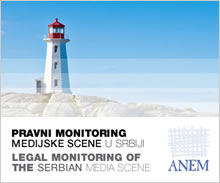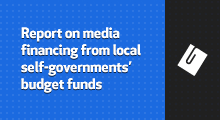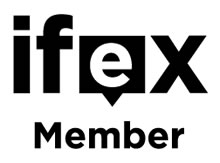Home
/
Media Scene
/
News Archive until September 2011
26. 01. 2006
LOCALS WEIGHING UP
BELGRADE, January 26, 2006 – The call for public competition for frequency licenses has been announced yesterday. The competition was prepared in line with the Broadcast Act, brought on July 18, 2002 by the Serbian Parliament. The competition envisages five national frequencies for five TV and radio stations on the territory of Serbia, one TV and radio station for broadcasting on the territory of Vojvodina, and 6 TV and 14 radio stations on the territory of Belgrade region. All interested to apply for the national frequency license will have 60 days to submit their applications, after which the Broadcast Agency will decide on the successful candidates within 90 days. According to the competition requirements, the applicants must submit their technical, organizational and program documentation, together with 15 million dinars of deposit for TV stations or 300.000 dinars for radio stations for program broadcasting in Belgrade region. There are currently more than a few private TV and radio stations that cover the territory of the Province – RTV Delta, TV Most, TV Super, TV Panonija, TV Melos, TV Metropolis, TV Santos, TV Bap, TV Pancevo, Sremska TV, TV Spektar, TV Kosava, TV Art and others. The number of radio stations covering Vojvodina is much higher, given the fact that over 50 radio programs can be heard on the frequency scale from 88 to 108 MHz, even though the majority of them broadcast program outside Novi Sad. As the director of TV Most Dusan Bajatovic told the Belgrade daily, this station will compete for program broadcasting in Vojvodina as well as Belgrade region. “I was surprised with the offer for the frequency in Vojvodina; however, I still think the fee is too high for any commercial television station that currently broadcasts in this region. According to my latest information, 23 million dinars a year need to be secluded for the working permit, but, beside this, a station also needs to establish the network of transmitters within 60 days in order to meet all the requirements for the competition. Naturally, this is an additional investment. I believe that currently none of the commercial stations currently broadcasting on the territory of Vojvodina can compete under such conditions. TV Most will also run for the territory of Vojvodina and Belgrade. We have engaged an expert team to rapidly produce a detailed analysis of the actual costs. Then we will see if the competition for this coverage is worthwhile and what frequency we will compete for”, said Bajatovic. TV Panonija director Zoran Andric claims it is too early to decide what frequency this station will apply for. “The only good thing is that, three and a half years after the adoption of the Broadcast Act, the competition for the frequency licenses has been finally announced, and I truly believe it will bring some order into this media chaos at last. We could not function in unregulated conditions such as these. I also think the fee for the use of frequencies is more or less realistic, but, on the other hand, we have only 60 days to decide if its worth our while or not”, Andric said. Even the director of TV Super Velimir Kostadinov could not give more precise details of whether this station from Subotica would compete for the frequency. “We have enough time to make the thorough analysis and estimation of what it would mean to our TV station. One thing is sure – we are currently the most equipped and technically the most modern station, with the ratings that put us among the top ten TV stations. We have thus met all the requirements of the competition so we won’t rush with our decision”, said Kostadinov, adding however that the payment rate for the frequency license was not at all low. The frequency competition also foresees one frequency for the radio station on the territory of Vojvodina, for which the station would need to pay 4.555.035 dinars. Radio Sajam will, most likely, decide to “skip” this round of the competition for frequencies. Chief-editor Marijeta Lazor said this radio station had all aspirations for the regional coverage, but it first needed to produce a business plan and analysis of all options, possibilities and costs, in order to decide which frequency the station would apply for. “Of course, the competition will finally regulate the broadcasting sphere, which is really a good thing, by giving the broadcast licenses only to those outlets which comply with all the technical and technological conditions for program broadcasting. After the analysis which would give us the real picture of necessary expenses and taxes, we will make our decision, however, it is less likely that we will compete in the first round. The station will probably apply for the second round of the competition, when licenses will be issued for regional and local frequencies”, said Lazor. According to the director of the Novi Sad-based Radio 021 Slobodan Stojsic, the payment rates will certainly create problems for many of the competing stations. “There is no such thing as luck in the radio broadcasting business. The market is rather small, where one radio station can get only 4 percent from advertising, in comparison to TV stations which earn 80 percent. It is very hard to survive in cruel conditions such as these, particularly for the socially responsible radio stations, like Radio 021. It is even harder with fees so high. The conduct expenses are enormous, especially for the informative programs, so the station must turn to the total commercialization in order to survive. It’s needless to say how essential the informative programs and stations are to this society”, Stojsic noted. The call for the applications will last 60 days, after which the applications will be assessed. The time envisaged for this is 90 days, and the whole procedure is expected to end by the end of April. The licenses will be issued for the period of eight years. The Broadcast Agency Council deputy chairman Aleksandar Vasic denied the claims that the fees in other countries in the region were lower, saying that they rather had two types of fees for the broadcast licenses. “One fee includes the regulation, while the other is a direct concession for the national goods, set by the state. Our legislation has not foreseen this, so the fee for broadcast licenses incorporates the concession”, Vasic explained.
-
No comments on this topic.





